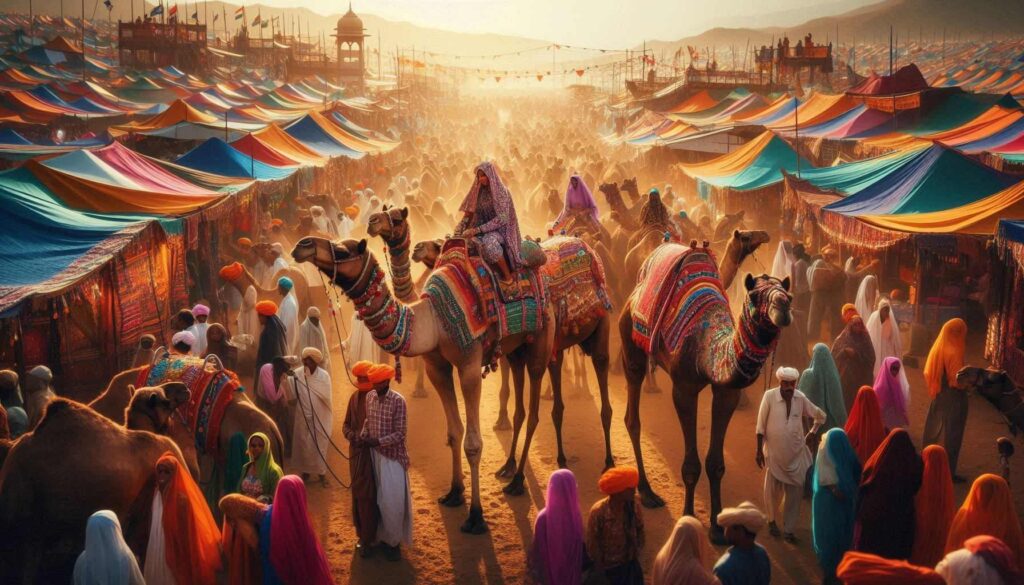Introduction
Rajasthan is a land of kings and warriors, marked by its majestic forts, palaces, and temples. The festivals celebrated here not only highlight the state’s artistic heritage but also foster community bonding and social cohesion. Each festival has its unique significance and is celebrated with much fervor. In this article, we will explore three significant festivals in Rajasthan in 2025—Gangaur, Teej, and Bundi—and delve into their traditions, rituals, and the essence they bring to the vibrant culture of Rajasthan.
Read More About Hindu Philosophy
1. Gangaur Festival

Significance
Gangaur is one of the most important festivals in Rajasthan, celebrated predominantly by women. The festival is dedicated to Goddess Gauri, a manifestation of Parvati, symbolizing marital bliss and the well-being of spouses. The festival generally falls in March or April, depending on the lunar calendar. It is a time for women to pray for the long life and prosperity of their husbands.
Celebrations and Rituals
Gangaur is celebrated with great zeal, particularly in cities like Jaipur, Udaipur, and Jodhpur. The festival spans 18 days, starting from the first day of Chaitra month and culminating on the day of Gangaur. Key rituals include:
- Goddess Gauri’s Idol Preparation: Women prepare clay idols of Goddess Gauri and Lord Shiva, adorned with traditional jewelry and clothing.
- Processions: On the last day, women dress in their finest attire, carry the idols to local water bodies, and perform puja (prayer). The processions are vibrant, with music, dance, and cultural performances.
- Community Celebrations: Women gather in groups, singing folk songs and exchanging sweets, reinforcing community bonds.
Cultural Relevance
Gangaur symbolizes the deep-rooted traditions of Rajasthan and reflects the reverence for marital relationships. The festival provides an opportunity for women to come together, share their experiences, and celebrate their roles as nurturers and caretakers.
2. Teej Festival

Significance
Teej is another significant festival celebrated in Rajasthan, primarily by married women. This festival marks the arrival of the monsoon season and is dedicated to Goddess Parvati, who is believed to have reunited with Lord Shiva after years of penance. Teej is typically celebrated in July or August.
Celebrations and Rituals
Teej celebrations are characterized by various rituals and cultural activities, including:
- Fasting: Women observe a day-long fast, praying for the well-being of their husbands. They begin the day by applying henna on their hands and wearing traditional attire.
- Swinging on Teej (Jhoolay): Women enjoy swinging on decorated swings, symbolizing joy and togetherness.
- Cultural Programs: The day is filled with folk music, dance performances, and storytelling, celebrating the essence of femininity and strength.
- Processions: In some regions, colorful processions featuring decorated elephants and camels take place, showcasing Rajasthan’s royal heritage.
Cultural Relevance
Teej highlights the importance of women in society and emphasizes their role in nurturing relationships. The festival brings families together and strengthens marital bonds, reinforcing the values of love, commitment, and devotion.
3. Bundi Festival

Significance
Bundi, a quaint town in Rajasthan, celebrates its annual Bundi Utsav, showcasing its rich cultural heritage. This festival usually takes place in October and November, attracting tourists and locals to experience the town’s charm and festivities. The festival highlights Bundi’s history, art, and craftsmanship.
Celebrations and Rituals
Bundi Utsav is a three-day festival filled with various events and activities, including:
- Cultural Performances: Traditional music and dance performances by local artists take center stage, showcasing the vibrant folk culture of Rajasthan.
- Art and Craft Exhibitions: Local artisans display their crafts, providing visitors with an opportunity to purchase handmade goods and souvenirs.
- Processions: The festival features grand processions with decorated elephants and camels, creating a carnival-like atmosphere.
- Fireworks Display: The nights are illuminated with spectacular fireworks, enchanting attendees and marking the festival’s grandeur.
Cultural Relevance
Bundi Utsav emphasizes the importance of preserving Rajasthan’s cultural heritage and promotes local craftsmanship. The festival provides a platform for artists and artisans to showcase their talents and connect with a broader audience.
4. Other Notable Festivals in Rajasthan
Apart from Gangaur, Teej, and Bundi, Rajasthan hosts several other remarkable festivals that highlight its rich culture and traditions:
- Mewar Festival: Celebrated in Udaipur, the Mewar Festival marks the arrival of spring and the harvest season. It features traditional music, dance, and a procession of beautifully adorned idols of Goddess Ganga and Lord Ganesha.

- Pushkar Camel Fair: This famous annual fair is held in Pushkar, attracting thousands of tourists and traders. The fair features camel trading, cultural performances, and competitions, making it a unique cultural experience.

Conclusion
The festivals of Rajasthan are a vibrant tapestry of culture, tradition, and spirituality. Celebrated with immense fervor and joy, they not only reflect the rich heritage of the state but also foster a sense of community and togetherness. As we look forward to 2025, these festivals continue to play a significant role in preserving and promoting Rajasthan’s unique identity. Participating in these celebrations offers a glimpse into the state’s traditions and values, making it a must-experience for both locals and tourists.


